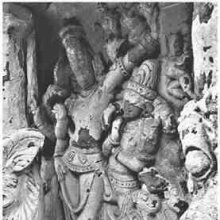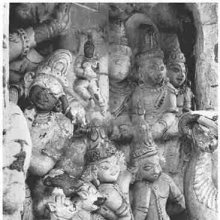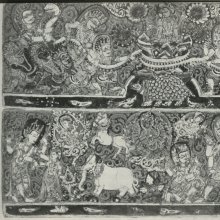Ocean: 3 definitions
Introduction:
Ocean means something in Buddhism, Pali, Hinduism, Sanskrit. If you want to know the exact meaning, history, etymology or English translation of this term then check out the descriptions on this page. Add your comment or reference to a book if you want to contribute to this summary article.
Images (photo gallery)
(+16 more images available)
In Hinduism
Yoga (school of philosophy)
Source: ORA: Amanaska (king of all yogas): A Critical Edition and Annotated Translation by Jason BirchOceans can be stopped, as part of the powers granted to one following certain Yoga practices, according to the Brahmayāmala-tantra (or Picumata), an early 7th century Śaiva text consisting of twelve-thousand verses.—Accordingly, [while describing a haṭha-sādhana (foreceful practice)]: “[When the Sādhaka] remains [in the hole] for up to one day, he is freed from all sins. [...] On the fourth, he is sure to see [the Yoginī,] Pūtanā, along with the Mothers. On the fifth day, in the middle of the night, he draws near the Yakṣas and Nāgas, stops the oceans (samudra), and death [no longer] exists for him. [...]”

Yoga is originally considered a branch of Hindu philosophy (astika), but both ancient and modern Yoga combine the physical, mental and spiritual. Yoga teaches various physical techniques also known as āsanas (postures), used for various purposes (eg., meditation, contemplation, relaxation).
Shilpashastra (iconography)
Source: Shodhganga: Elements of Art and Architecture in the Trtiyakhanda of the Visnudharmottarapurana (shilpa)The Oceans (personified) follows specific guidelines of ancient Indian Painting (citra), according to the Viṣṇudharmottarapurāṇa, an ancient Sanskrit text which (being encyclopedic in nature) deals with a variety of cultural topics such as arts, architecture, music, grammar and astronomy.—In the Viṣṇudharmottarapurāṇa, the technique of personification is seen to be used in the context of Painting also. According to the Viṣṇudharmottarapurāṇa, the oceans should be personified and the picture of the ocean should contain a jewel-vessel and should be shown partially with the signs of weapon in hands.

Shilpashastra (शिल्पशास्त्र, śilpaśāstra) represents the ancient Indian science (shastra) of creative arts (shilpa) such as sculpture, iconography and painting. Closely related to Vastushastra (architecture), they often share the same literature.
In Buddhism
Tibetan Buddhism (Vajrayana or tantric Buddhism)
Source: ORA: Amanaska (king of all yogas): (Tibetan Buddhism)The Ocean (in Sanskrit: Sāgara) can be controlled by one having the Siddhi (power) of Speech, according to verse 14.24bd-27 of the Laghuśaṃvara, an ancient Buddhist Yoginī Tantra.—Accordingly: “The Sādhaka [who has] the Siddhi of speech can certainly attract a king or queen by [merely] thinking [it]. [...] And he can stop a river, a cart, a machine [like a water-wheel,] the ocean (sāgara), elephants and horses, clouds, a man or bird merely by means of his speech. He achieves everything which he desires by his speech”.

Tibetan Buddhism includes schools such as Nyingma, Kadampa, Kagyu and Gelug. Their primary canon of literature is divided in two broad categories: The Kangyur, which consists of Buddha’s words, and the Tengyur, which includes commentaries from various sources. Esotericism and tantra techniques (vajrayāna) are collected indepently.
See also (Relevant definitions)
Starts with: Oceanblue morning-glory.
Full-text (+4861): Arnava, Sagara, Mahodadhi, Samudra, Jaladhi, Udadhi, Abdhi, Sindhu, Maharnava, Jalanidhi, Payodhi, Ambudhi, Bhuvis, Ratnakara, Vahinipati, Niranidhi, Apampati, Varidhi, Ambhodhi, Toyadhi.
Relevant text
Search found 377 books and stories containing Ocean; (plurals include: Oceans). You can also click to the full overview containing English textual excerpts. Below are direct links for the most relevant articles:
The Skanda Purana (by G. V. Tagare)
Chapter 14 - The Greatness of Catussamudra < [Section 1 - Avantīkṣetra-māhātmya]
Chapter 17 - Annihilation by Twelve Suns < [Section 3 - Revā-khaṇḍa]
Chapter 70 - Greatness of Varuṇeśvara (Varuṇa-īśvara) < [Section 1 - Prabhāsa-kṣetra-māhātmya]
Was there a Western Ocean in North India < [October – December, 2000]
Ocean < [October – December, 1985]
Oceans and Mountains < [March-April 1931]
Tattvartha Sutra (with commentary) (by Vijay K. Jain)
Verse 3.7 - The transverse world (tiryagloka) < [Chapter 3 - The Lower World and the Middle World]
Verse 3.8 - The successive extension of continents and oceans < [Chapter 3 - The Lower World and the Middle World]
Verse 3.33 - The regions in Dhātakīkhaṇḍa < [Chapter 3 - The Lower World and the Middle World]
Kavyamimamsa of Rajasekhara (Study) (by Debabrata Barai)
Part 8.2 - Rājaśekhara’s concepts of Seven Mahādvīpas (islands) < [Chapter 5 - Analyasis and Interpretations of the Kāvyamīmāṃsā]
Part 7.6 - Poetic conventions regarding to the Oceans and Water < [Chapter 5 - Analyasis and Interpretations of the Kāvyamīmāṃsā]
Part 7.13 - Poetic conventions regarding to the Moon < [Chapter 5 - Analyasis and Interpretations of the Kāvyamīmāṃsā]
Manusmriti with the Commentary of Medhatithi (by Ganganatha Jha)
Verse 2.22 < [Section VI - Qualified Countries]
Verse 1.24 < [Section XII - Creation of Time]
Verse 1.105 < [Section LXI - Results accruing from the study of the Institutes]
Trishashti Shalaka Purusha Caritra (by Helen M. Johnson)
Part 31: Description of Nandīśvara < [Chapter III - The initiation and omniscience of Ajita]
Part 21: Description of the Middle World (madhyaloka) < [Chapter III - The initiation and omniscience of Ajita]
Part 31: The Antaradvīpas < [Chapter III - The initiation and omniscience of Ajita]
Related products
(+9 more products available)











